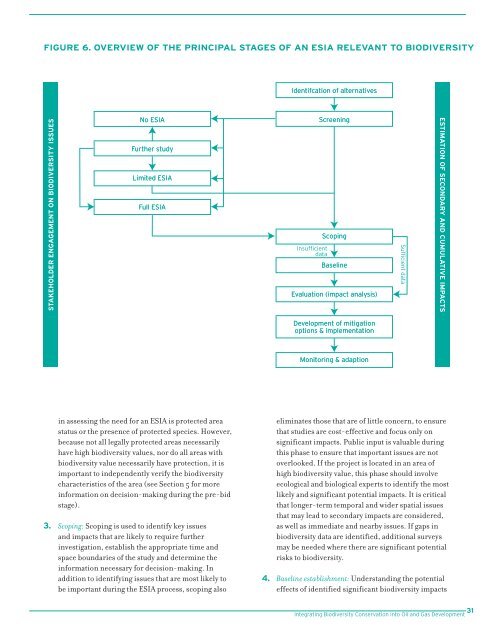Integrating Biodiversity Conservation into Oil and Gas ... - EBI
Integrating Biodiversity Conservation into Oil and Gas ... - EBI
Integrating Biodiversity Conservation into Oil and Gas ... - EBI
You also want an ePaper? Increase the reach of your titles
YUMPU automatically turns print PDFs into web optimized ePapers that Google loves.
FIGURE 6. OVERVIEW OF THE PRINCIPAL STAGES OF AN ESIA RELEVANT TO BIODIVERSITY<br />
Identifcation of alternatives<br />
STAKEHOLDER ENGAGEMENT ON BIODIVERSITY ISSUES<br />
No ESIA<br />
Further study<br />
Limited ESIA<br />
Full ESIA<br />
Insufficient<br />
data<br />
Screening<br />
Scoping<br />
Baseline<br />
Evaluation (impact analysis)<br />
Sufficient data<br />
ESTIMATION OF SECONDARY AND CUMULATIVE IMPACTS<br />
Development of mitigation<br />
options & implementation<br />
Monitoring & adaption<br />
in assessing the need for an ESIA is protected area<br />
status or the presence of protected species. However,<br />
because not all legally protected areas necessarily<br />
have high biodiversity values, nor do all areas with<br />
biodiversity value necessarily have protection, it is<br />
important to independently verify the biodiversity<br />
characteristics of the area (see Section 5 for more<br />
information on decision-making during the pre-bid<br />
stage).<br />
3. Scoping: Scoping is used to identify key issues<br />
<strong>and</strong> impacts that are likely to require further<br />
investigation, establish the appropriate time <strong>and</strong><br />
space boundaries of the study <strong>and</strong> determine the<br />
information necessary for decision-making. In<br />
addition to identifying issues that are most likely to<br />
be important during the ESIA process, scoping also<br />
eliminates those that are of little concern, to ensure<br />
that studies are cost-effective <strong>and</strong> focus only on<br />
significant impacts. Public input is valuable during<br />
this phase to ensure that important issues are not<br />
overlooked. If the project is located in an area of<br />
high biodiversity value, this phase should involve<br />
ecological <strong>and</strong> biological experts to identify the most<br />
likely <strong>and</strong> significant potential impacts. It is critical<br />
that longer-term temporal <strong>and</strong> wider spatial issues<br />
that may lead to secondary impacts are considered,<br />
as well as immediate <strong>and</strong> nearby issues. If gaps in<br />
biodiversity data are identified, additional surveys<br />
may be needed where there are significant potential<br />
risks to biodiversity.<br />
4. Baseline establishment: Underst<strong>and</strong>ing the potential<br />
effects of identified significant biodiversity impacts<br />
31<br />
<strong>Integrating</strong> <strong>Biodiversity</strong> <strong>Conservation</strong> <strong>into</strong> <strong>Oil</strong> <strong>and</strong> <strong>Gas</strong> Development
















![[PDF] Community Development Toolkit - CommDev](https://img.yumpu.com/48616495/1/184x260/pdf-community-development-toolkit-commdev.jpg?quality=85)
